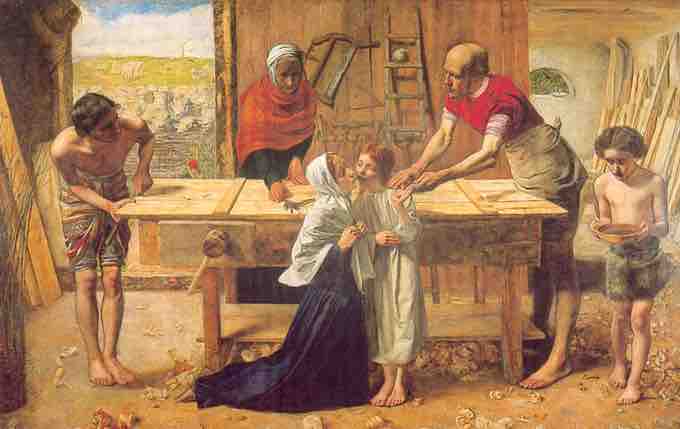The Pre-Raphaelite Brotherhood (also known as the Pre-Raphaelites) was a group of English painters, poets, and critics, founded in 1848 by William Holman Hunt, John Everett Millais and Dante Gabriel Rossetti. The three founders were soon joined by William Michael Rossetti, James Collinson, Frederic George Stephens and Thomas Woolner to form a seven-member "brotherhood". The group's intention was to reform art by rejecting an approach that they considered mechanistic, one that was first adopted by the Mannerist artists who succeeded Raphael and Michelangelo. Its members believed the Classical poses and elegant compositions of Raphael in particular had been a corrupting influence on the academic teaching of art, hence the name "Pre-Raphaelite". The Pre-Raphaelites wanted a return to the abundant detail, intense colours and complex compositions of Quattrocento Italian and Flemish art. The Pre-Raphaelites defined themselves as a reform movement, created a distinct name for their form of art, and published a periodical, The Germ, to promote their ideas.
The brotherhood's early doctrines emphasized the personal responsibility of individual artists to determine their own ideas and methods of depiction. Influenced by romanticism, the Pre-Raphaelites thought freedom and responsibility were inseparable. Nevertheless, they were particularly fascinated by medieval culture, believing it to possess a spiritual and creative integrity that had been lost in later eras.
Pre-Raphaelites and Realism
The emphasis on medieval culture clashed with principles of realism, which stressed the independent observation of nature. In its early stages, the Pre-Raphaelite Brotherhood believed its two interests were consistent with one another, but in later years the movement divided and moved in two separate directions. The realists were led by Hunt and Millais, while the medievalists were led by Rossetti and his followers, Edward Burne-Jones and William Morris. The split was never absolute, since both factions believed that art was essentially spiritual in character, opposing their idealism to the materialist realism associated with Courbet and impressionism.
The Pre-Raphaelite Brotherhood was greatly influenced by nature and its members used great detail to show the natural world using bright and sharp focus techniques on a white canvas. In attempts to revive the brilliance of colour found in Quattrocento art, Hunt and Millais developed a technique of painting in thin glazes of pigment over a wet white ground in the hope that the colours would retain jewel-like transparency and clarity. Their emphasis on brilliance of color was a reaction to the excessive use of bitumen by earlier British artists . Bitumen produces unstable areas of muddy darkness, an effect the Pre-Raphaelites despised.

Ophelia
Ophelia, by John Everett Millais reflects the Pre-Raphaelite use of brilliance of color in composition.
Exhibitions
The first exhibitions of Pre-Raphaelite work occurred in 1849. Both Millais's Isabella (1848–1849) and Holman Hunt's Rienzi (1848–1849) were exhibited at the Royal Academy. Rossetti's Girlhood of Mary Virgin was shown at a Free Exhibition on Hyde Park Corner. As agreed, all members of the brotherhood signed their work with their name and the initials "PRB. "
In 1850 the Pre-Raphaelite Brotherhood became the subject of controversy after the exhibition of Millais's painting, Christ in the House of His Parents, considered to be blasphemous by many reviewers, notably Charles Dickens. The brotherhood's medievalism was attacked as backward-looking and its extreme devotion to detail was condemned as ugly and jarring to the eye. According to Dickens, Millais made the Holy Family look like alcoholics and slum-dwellers, adopting contorted and absurd "medieval" poses.

Christ in the House of His Parents
Pre-Raphaelite Millais's painting, Christ in the House of His Parents, was considered to be blasphemous by many reviewers, notably Charles Dickens, who said Millais made the Holy Family look like alcoholics and slum-dwellers, adopting contorted and absurd "medieval" poses.
After 1856, Dante Gabriel Rossetti became an inspiration for the medievalising strand of the movement. He was the link between the two types of Pre-Raphaelite painting (nature and romance) after the PRB became lost in the late 1800s. Rossetti, although the least committed to the brotherhood, continued the name and changed its style. He began painting versions of women using models like Jane Morris, in paintings such as Proserpine, after the Pre-Raphaelites had disbanded.
Since the Pre-Raphaelites were fixed on portraying subjects with near-photographic precision—though with a distinctive attention to detailed surface-patterns—their work was devalued by many painters and critics. For instance, after the First World War, British Modernists associated Pre-Raphaelite art with the repressive and backward times in which they grew up.